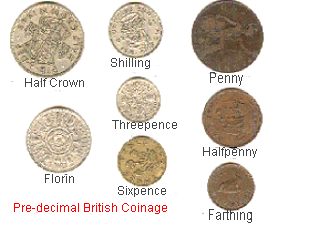|
The History of Modern Coinage in Gt.
Britain
Until 1971, when the British coinage was converted to decimalisation, the coins
in use were pounds, shillings and pence, based on the Latin names "Librae, Solidii,
Denarii" or £. s. d.
In addition to the gold, silver and copper coins there were banknotes issued by the
Bank of England. These were most commonly in the values of ten shillings, one pound
and five pound notes.
Work began on a purpose-built mint in 1805. Located on Tower Hill, London it was
called the Royal Mint. Matthew Boulton supplied its machinery. The first silver coins
from what was called the Royal Mint were placed into circulation in 1816. The following
year a gold coinage was issued based on the sovereign (one pound) rather than the
guinea (one pound and one shilling), which had been the principal gold unit since
1663.
Although there was an attempt to introduce a decimal coinage in 1849, this failed.
A florin, or two-shilling piece, being a tenth of a pound, was placed into circulation
to start the process. However the system where 12 pence equalled 1 shilling, and
20 shillings equalled 1 pound continued for more than a century. The reason why "pence"
was represented by d is that it was an abbreviation for denarius, which
was the equivalent of a penny in Roman times. The coinage was finally decimalized
in 1971 with a coinage in which 100 pence equals 1 pound.

Styles of signifying money values:
Copper Coins
| One farthing (the smallest coin) worth a quarter
of one penny was shown as |
1/4d |
| A halfpenny worth half a penny was usually called
a ha'penny " |
1/2d |
| One penny worth one 240th of one pound (twenty
shillings) " |
1d |
Silver Coins (actually an alloy of silver colour)
Silver threepenny bit was replaced with a many
sided coin "
(These silver coins continued to be used as a good luck charm in Xmas Puddings) |
3d |
| Six pence (known as "a tanner" - derivation
unknown) was shown as |
6d |
One shilling value twelve pence- twenty shillings
equalled one pound
(A shilling was also called a "bob"- derivation unknown) |
1/- |
| One florin worth 24 pence made 10 to the pound |
2/- |
| Half a crown or two and sixpence (often referred
to as half-a -dollar.) |
2/6 |
| There was once a crown coin but no longer in
circulation. |
5/- |
Gold Coins
| Sovereign (nominal value of twenty shillings
but had an actual value many times higher because of its precious metal content) |
| Guinea (nominal value of twenty one shillings
but again because of it's gold content worth much more). |
Bank Notes
| Ten shillings |
the equivalent of 120 pence. |
10/- |
| One Pound |
the equivalent of twenty shillings |
£1-0-0 |
| Five Pounds |
(originally white and of considerable size;
later printed in colour) |
£5-0-0 |
| There were also 50 pound notes and 100 pound notes. |
£50 and £100 |
return
to Travel in Wales
|